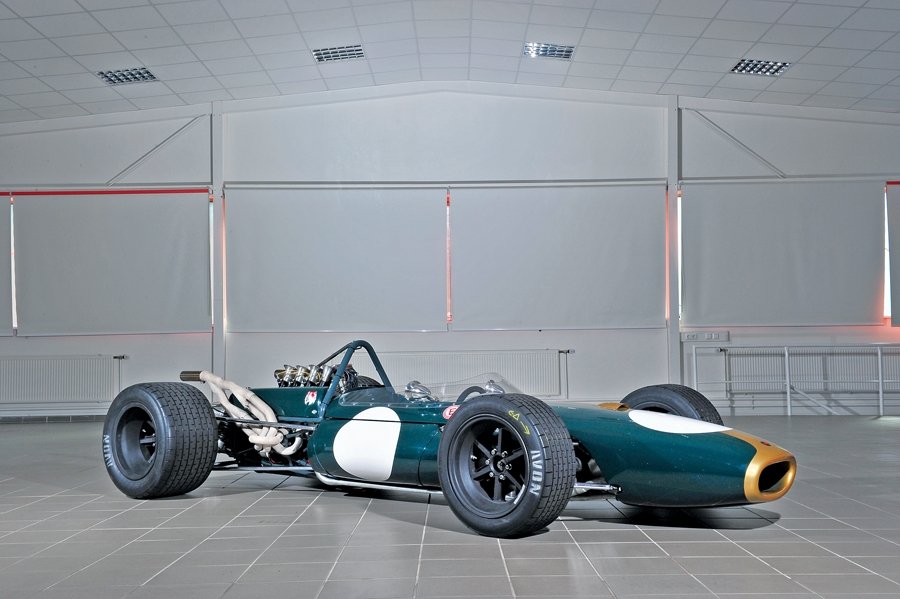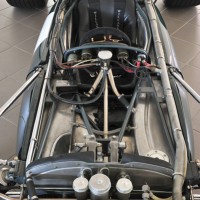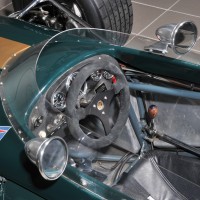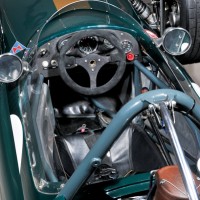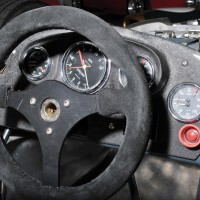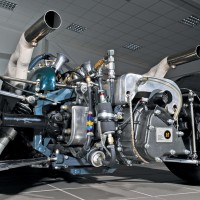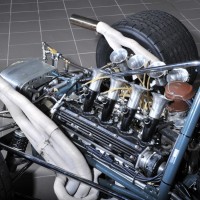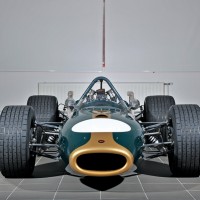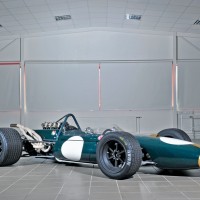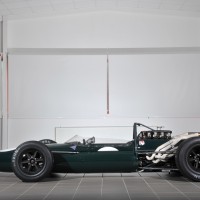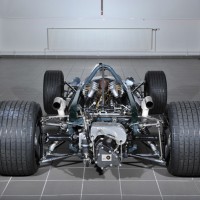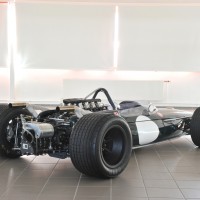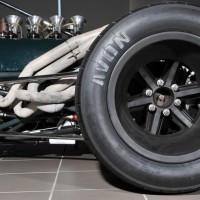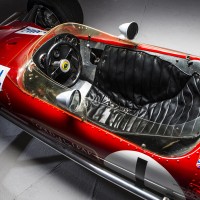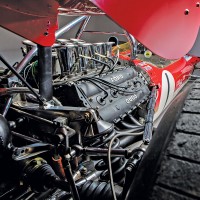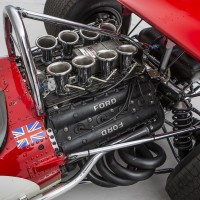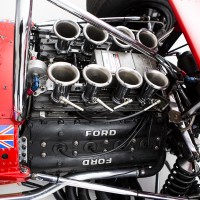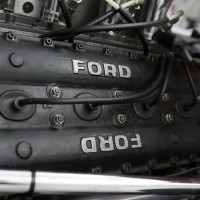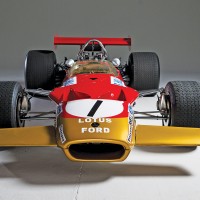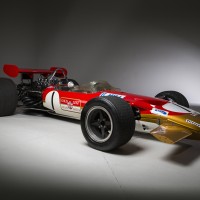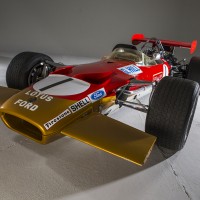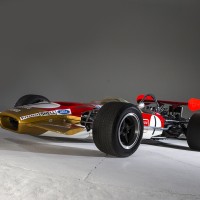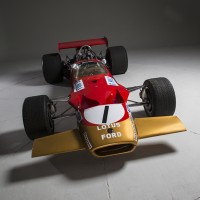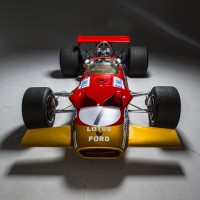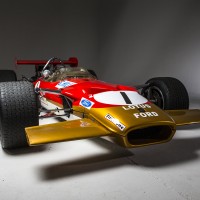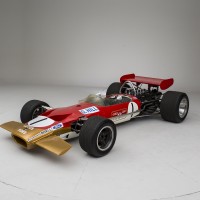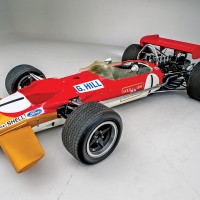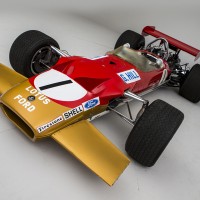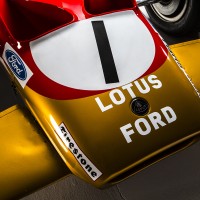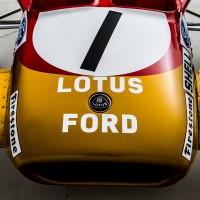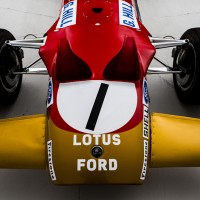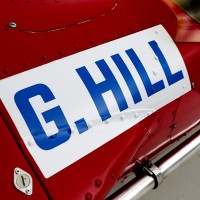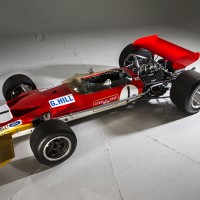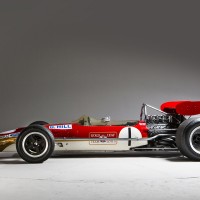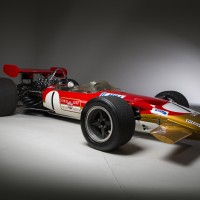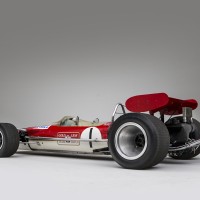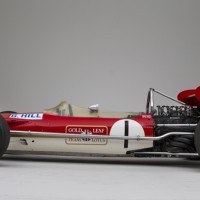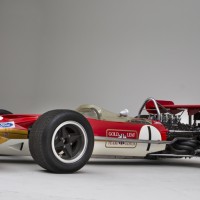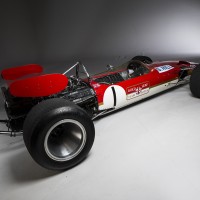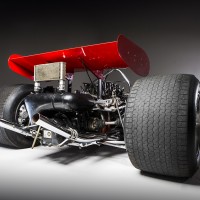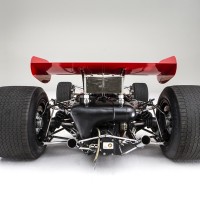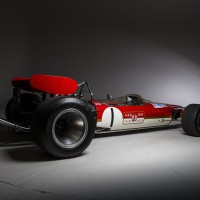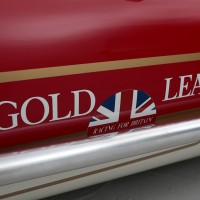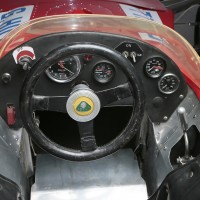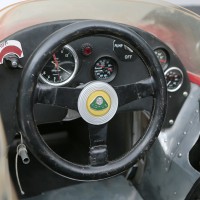1966 Brabham-Repco BT20 F1
When the FIA announced in late 1963 that a 3-liter limit would be imposed on Formula One racing in 1966, a scramble ensued among competitors to develop suitable new engines. Jack Brabham turned to Repco, an Australian parts supplier. Development centered on Oldsmobile’s F-85 V8 block, which offered the advantage of a pre-existing and proven crankcase to create a 300-hp, 2,994-cc SOHC V8 engine. Jack Brabham began the 1966 season driving the sole BT19 chassis, but within a matter of months, two BT20 cars were built. Chassis F1266, the second of these two cars, commenced racing at the French Grand Prix on July 3, 1966, achieving the 3rd place finish. Two weeks later, at the British Grand Prix, Hulme roared to a 2nd place finish and then 3rd at Monza on September 4. Another 2nd place at Oulton Park followed on September 17, with a 3rd place at the season-concluding Mexican Grand Prix on October 23, sealing Brabham’s 1966 Constructors’ Championship. The 1967 season proved to be even more significant for F1266, as the car became a focal point of the Brabham team’s efforts. The car was driven exclusively by Hulme for the first half of the season, finishing 4th at Kyalami on January 2, 2nd at Oulton Park on April 15, and taking its first checkered flag on May 7 at the Monaco Grand Prix. This car, Lot 179, sold for $1,502,701, including buyer’s premium, at RM’s Monaco auction on May 10, 2014.1968–69 Lotus-Cosworth Ford Type 49B F1
On June 4, 1967, Formula One motor racing’s entire world was turned upside down by what transpired in the Dutch Grand Prix race at Zandvoort. The British Lotus team had arrived for that Grand Prix with two brand-spanking-new Formula One cars in their transporter. Star driver Graham Hill had immediately qualified his on pole position for its debut race. On race day he had led before his new Cosworth-Ford DFV engine failed, whereupon his teammate Jim Clark had taken over, set fastest lap, and ran away to an utterly dominant victory. The brand-new Lotus-Ford Type 49 had completely rewritten 3-Liter Formula One’s contemporary performance standards. In effect, only nine Lotus-Ford 49s were built (and rebuilt again) under twelve chassis numbers, from 1967 to ’69. In three seasons, the Lotus-Ford 49 won 12 World Championship-qualifying Grand Prix races, while the Cosworth DFV V8 engine became the first Formula One unit ever to score 100 victories — and ended up with 155 to its credit. Only six of these transcendent Formula One cars survive today. Since this now-legendary Lotus design then saw frontline service through no fewer than four Formula One seasons, 1967–70, the Type 49 also became one of the longest-lived of Grand Prix car designs. This car, Lot 342, sold for $1,147,136, including buyer’s premium, at Bonhams’ Goodwood Auction on June 27, 2014.SCM Analysis
Detailing
| Number Produced: | Brabham BT20, two; Lotus 49, nine (six remain) |
| Original List Price: | N/A |
| Chassis Number Location: | Varies |
| Engine Number Location: | Varies |
| Club Info: | Historic Grand Prix Cars Association |
| Website: | http://www.hgpca.net |
| Alternatives: | McLaren M7A, Ferrari 312, BRM P-126 |
| Investment Grade: | A |
Regular readers of this profile know that I frequently assert that any vintage racing car is valued based on a combination of “weapons-grade” values (the ones relating to actually racing a car) and “collector” values (intangible ones related to all the other reasons why you’d want to own one). In general, I also believe that selling primarily weapons-grade cars at auction is a terrible idea.
This is because the bidder pool for these cars is small and pragmatic: They know exactly what they are bidding on and why they want to buy. The proverbial wild card “trial lawyer from Dallas” who drives the bidding with emotion because “it will look cool in my collection” isn’t there to force the price up. It’s really tough to sell pure racing cars at auction. In short, assuming you are knowledgeable and careful, there is nothing wrong with buying a weapons-grade car at auction (it’s often an advantage), but being the consignor is a very risky proposition.
Today’s subject cars are two Formula One racers that are very similar (they are both first-generation 3-liter F1 cars with good histories) and also profoundly different in both the weapons and collector values they offer. Interestingly, the prices realized in the two sales are roughly the inverse of what I, at least, would have expected, and trying to figure out what we can learn from this is our challenge for today.
Built to race — and only to race
To start with, any formula (open-wheeled) racer is by definition a weapons-grade car. You can’t take it to the grocery store or on a tour, and your wife’s garden club (or your own country-club friends, for that matter) won’t stop and admire its voluptuous curves in passing. It’s also unlikely that you will be qualified to tinker with it.
They were built to race and win on a professional level, and that’s pretty much it. That said, Grand Prix cars certainly have collector values worth paying for — you just have to understand what they are.
The most basic is the antique collectors’ adage: “What was special then is special now.” Even the most plebian of GP cars at some point played at the absolute pinnacle of the sport, were watched and/or cheered by hundreds of thousands of spectators, and had some role to play in that most extreme of blood sports — Grand Prix racing. It’s a subtler vibe than the “Ooh, can I touch it?” macho sexiness of some sports racers, but just as real. GP cars can be damned charismatic and handsome.
Add in good stories…
The best cars, of course, have stories to tell along with physical attractiveness, and the more and greater the stories, the more collector value a car will have. They can be of personal courage and charisma (great drivers and great races), or of innovation and importance to the development of the sport (we’ll discuss the Lotus 49 shortly), or just sheer quirkiness, but the more stories the better.
These two cars have very different stories.
The Brabham BT20 played a huge part in Brabham’s 1966 and 1967 world championships, and it was arguably the dominant GP car of those years, but, in honesty, there wasn’t much competition. The beginning of the 3-liter formula seemed to catch everybody by surprise: Nobody had a good 3-liter race engine and the new chassis had to deal with both more horsepower and wider tires, so the cars of the first few years were more evolving experiments than developed concepts. The BT20 was beautiful, important and dominant, but it was not particularly fast — at least by the standards of the years to come. Denny Hulme took 2nd at Silverstone in 1966 with an average lap time of 1:40.
The Lotus 49 came along in mid-1967 and is arguably the most significant and successful car in Grand Prix history. With a monocoque front tub mounted to a stressed-member engine — and introducing the Cosworth DFV engine that would dominate 3-liter racing for the next 10 years — the Lotus 49 made every car prior to its introduction instantly obsolete. With few exceptions (and no successful ones), every GP car that followed it was an attempt to be what it was. This car simply changed the paradigm. The car was a front-runner for four seasons and remained in the hunt after that. In the 1969 Silverstone GP, a Lotus 49C turned a lap time of 1:30.
Track-weapon value
Both cars have plenty of stories to tell, although the Lotus 49 has far greater and more compelling ones than the Brabham, so it should have greater collector value.
What about the competitive side of things? The problem here is that the FIA sets the vintage GP grid for the early cars as 1966 through 1972.
The winning 1972 car at Silverstone had an average lap time of 1:25, 15 seconds a lap faster than the Brabham’s 1966 time and five seconds faster than the Lotus 49’s time, which means that if you care about winning the race (or even being mid-pack), the Brabham doesn’t have a chance.
Interestingly, the Lotus is close enough that with a good driver and careful improvements, it could run at or near the front, plus the Cosworth DFV is easy to maintain or replace, while the Repco engines are hens’-teeth rare and relatively fragile. The weapons-grade value clearly goes to the Lotus.
Why did the Brabham bring more?
Okay, so by my calculations the Lotus has the Brabham easily in both collector values and competitiveness. Why did the Brabham sell for $350k more than the Lotus? I don’t know, either.
I know of some private sales of pre-Lotus 49 3-liter cars that suggest that the Brabham sold at the high side of the range and of some private sales of Lotus 49s that suggest this one went for well under market. Why? My observation is that two consignors entered the “racing car at auction” lottery and for whatever reasons, one was successful and one was disappointed.
The Brabham was well sold, while the Lotus 49 was very, very well bought. ♦
(Introductory description courtesy of RM Auctions.)
